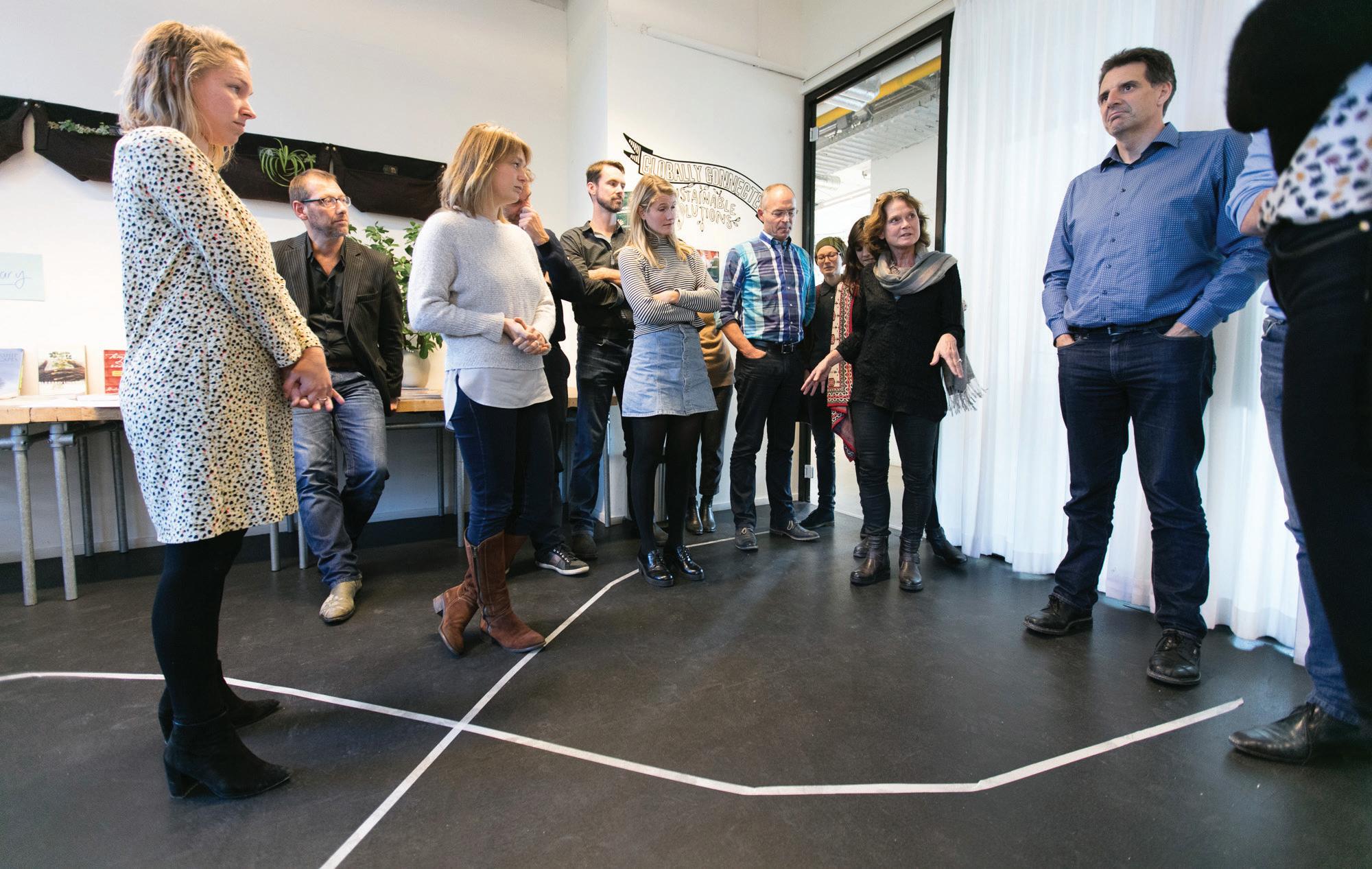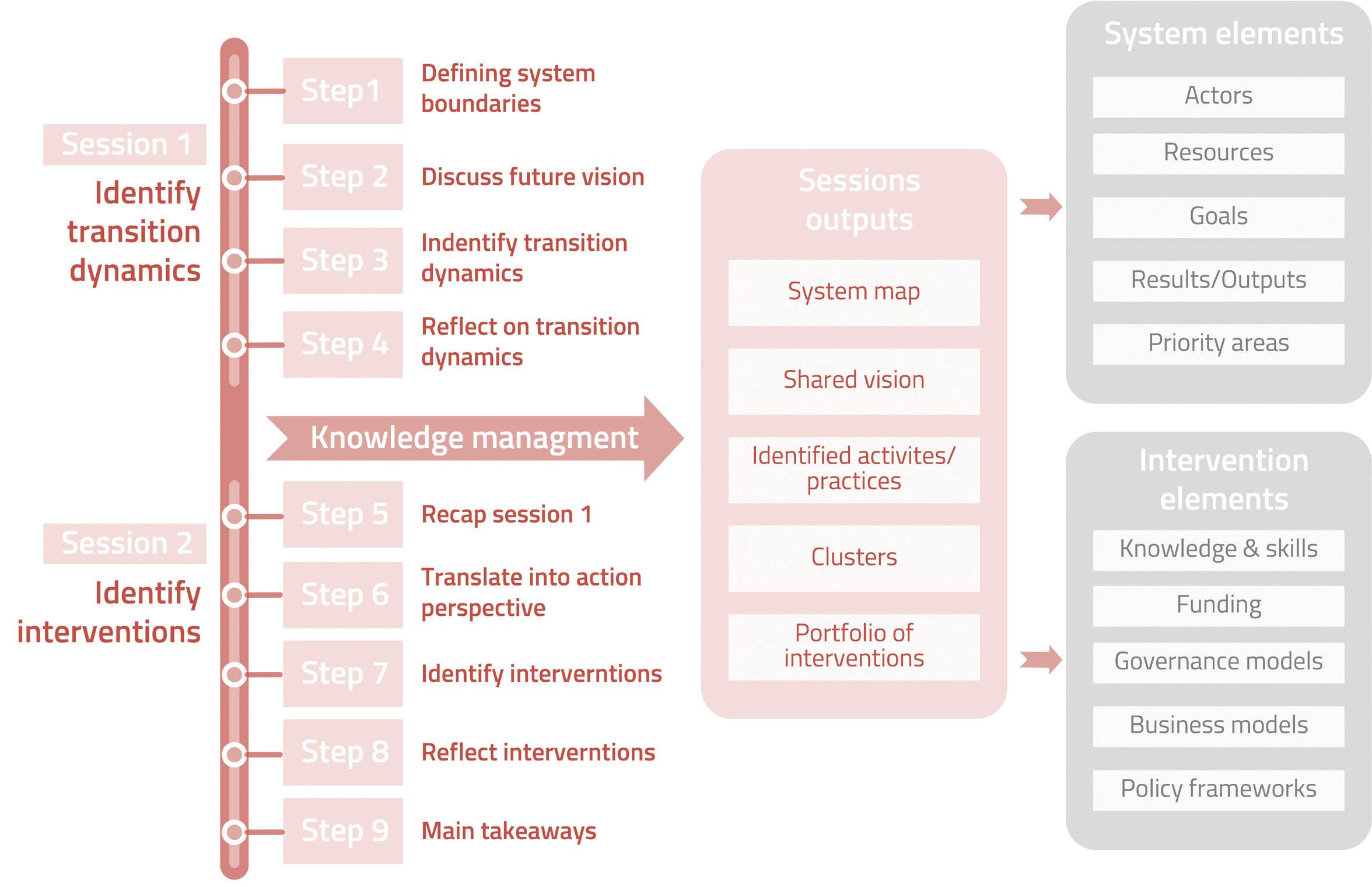
11 minute read
APPLICATION
from X curve transition
by Jeroen Boon
As a sensemaking tool, the X-Curve can be used as part of a short or longer process including a combination of co-creation workshops and desk research. As indicated before, four areas of application could be: System Mapping, Priority setting and Governance, Instrument mix and experiments, and Learning and institutional change.
In practice, the process can be divided in two main sessions:
Advertisement
A. Co-creation session 1: identifying transition dynamics.
B. Co-creation session 2: identifying interventions.
The nine steps across the two sessions and related outputs are presented in the figure on the next page. The first session can be done as a stand-alone session, but for the second session you need to understand the transition dynamics before you start identifying suitable interventions. There is no clear start or end, rather it is a looping process where the different sessions are interconnected by the knowledge management process, which in turn depends on the context of the implementation, the audience, and other related actions.
Delivery. The process described in the following pages can be led by a team of people covering a variety of responsibilities, such as the application of methods, liaising with with the target cases/projects to be discussed over the session and the management of the audience, including communication. A brief description of this team is presented later.
Preconditions. Following a challenge-led approach is the overall recommendation for the preparation of the process, which can be action-based or learning-oriented. Anchoring the process in specific cases, portfolios of projects or relevant policies facilitates a better flow throughout the process. No specific prior knowledge is required but an overall understanding of socio-technical systems and a familiarity with the cases to be discussed is recommended (i.e. audience can receive a case briefing in advance).
Knowledge management is introduced as a transversal practice to capitalise the outputs of the sessions and co-produce practice-based knowledge. It contributes to the effective mapping of relationships between sessions through the use of data and knowledge flows. It is aimed at supporting the common understanding of the set of elements embedded in the targeted system and the portfolio of interventions.
Target audience. Before the workshop starts, it is important that you define the target audience of your workshop. The X-Curve model can be a useful tool especially for policymakers, civil servants, civil society organisations or other stakeholders involved in sustainability transition processes at the city, regional or national level.
Goals and expected outcomes. An X-Curve workshop aims at creating awareness and shared meanings regarding the understanding of the transition dynamics within society or a specific context. A workshop can also help in identifying suitable interventions for different phases and aspects of these dynamics as part of a project-based discussions.
Duration. Before the workshop you need to consider the time needed for conducting the workshop in relation to your goal and expected outcomes. Half a day or four hours is the approximate time required for the organisation of each of the two co-creation sessions.
A detailed description of steps and principles for workshop design can be found in Challenge-Led System Mapping Handbook (EITClimate KIC) and Innovation Camps Handbook (JRC)
X-Curve workshop format – Sessions, steps and outputs
Co-creation session 1: Identifying transition dynamics
STEP 1: DEFINING SYSTEM BOUNDARIES
◎ Choose a system demarcation in advance, using functional or spatial boundaries or, as is most common, a combination. (For example: mobility system in Barcelona or energy system in Germany.)
◎ Usually, this system demarcation is a logical result based on the target audience or is something that is agreed upon beforehand with the challenge owner.
◎ The ideal size of a group is 5-7 people. With larger groups, you can split the group and choose to identify a different system per group, or have each group do the same system.
For example, all groups focus their analysis on the mobility system in Barcelona, or one group focuses on the mobility system, where others focus on energy and housing.
STEP 2: DISCUSS FUTURE VISION
Participants are invited to discuss their desired vision as a referential point for the analysis. They explore how radically different that vision is from the situation today. The final vision of the desired transition determines whether you see something as 'radically different' or just 'optimising the current system'. The X-Curve functions as a basis for a discussion about this. This is an important part of the exercise. Only in this way we can question certain unsustainable visions of the future and transition paths and make possible radical visions explicit.
Practical implementation:
◎ The shared vision can be available from previous workshops, conversations and documents.
◎ A challenge owner can pitch the existing vision for the case by using infographics, posters or any other material.
◎ The revisited vision can include a longer horizon to better use the X-Curve so make sure the vision is set in the far future (20-30 years, rather than 3-5 years). In this way, the discussion can be about a desired rather than an expected or calculated future.
◎ The vision is not so much about concrete and measurable targets (e.g. 50% less CO2), but more about aspirational goals (clean, inclusive, etc).
STEP 3: IDENTIFYING TRANSITION DYNAMICS
This step consists in supporting participants in understanding and discussing transition dynamics in a societal system by jointly identifying the different activities and practices that can currently be observed. Guiding questions help to drive the discussion to explore the patterns of transitions dynamics (e.g. acceleration or phase-out).
Make sure the focus is on observed activities/practices and not possible (future) interventions. This is for a later stage. Key actors and available resources can also be included as part of the description of the system defined.
Practical Implementation
◎ Prepare a blank X-Curve in advance on which (digitally or physically) Post-it notes can be affixed where appropriate.
◎ First, let participants reflect for themselves and write down ideas on (digital) Post-it notes or in a notebook.
◎ Focus the discussion on observed activities/practices and not possible (future) interventions. This is for a later stage.
◎ When the case is project related, expected results and outputs can also be reflected upon.
◎ Then paste Post-it notes or share findings and have one person fill in the details on the sheet.
◎ Active facilitation is desirable. Welcome requests for help or ensure that a facilitator is included to help participants on their way.
Guiding questions
• What new initiatives do you see emerging? Give as many examples as possible of sustainable and future-proof alternatives to the current system.
• Where do innovative developments really add up? Where do they become visible and accessible?

• Do you already see signs of a new normal? In both thinking, organising, and doing?
• Where is the focus on optimisation? For example, by improving the existing system instead of real transformation to a sustainable and future-proof system?
• Where do you see that previously established ideas, structures, and positions are now being abandoned, are no longer self-evident?
• Are there already narratives of breakdown and phasing out previously established ideas, structures, and positions?
• What current developments could you not have dared to predict five years ago?
• What did you expect five years ago that did not happen?
STEP 4: REFLECT ON TRANSITION DYNAMICS
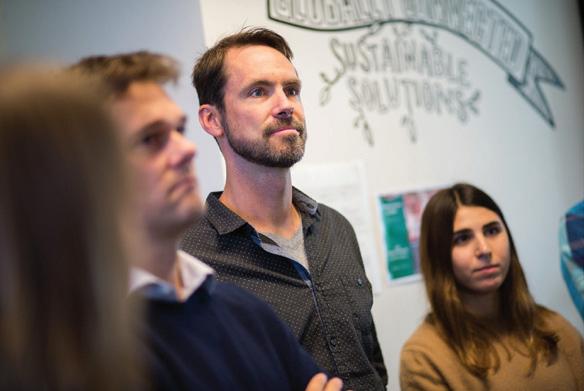
Focus on the newly harvested elements to make collective reflections per system on the image that becomes visible: what are the most significant transition dynamics? Group elements according to similarities and identify clusters that stand out due to minimal or significant activity. Use guiding questions to facilitate group discussion and run a plenary session to bring together reflections.
Afterward, wrap up the session and inform participants about the next steps of the process if you are planning on diving deeper into identifying interventions with co-creation session 2. Organise knowledge management actions to harvest and analyse all the necessary data to disseminate the results of the session and provide further input for subsequent discussions.
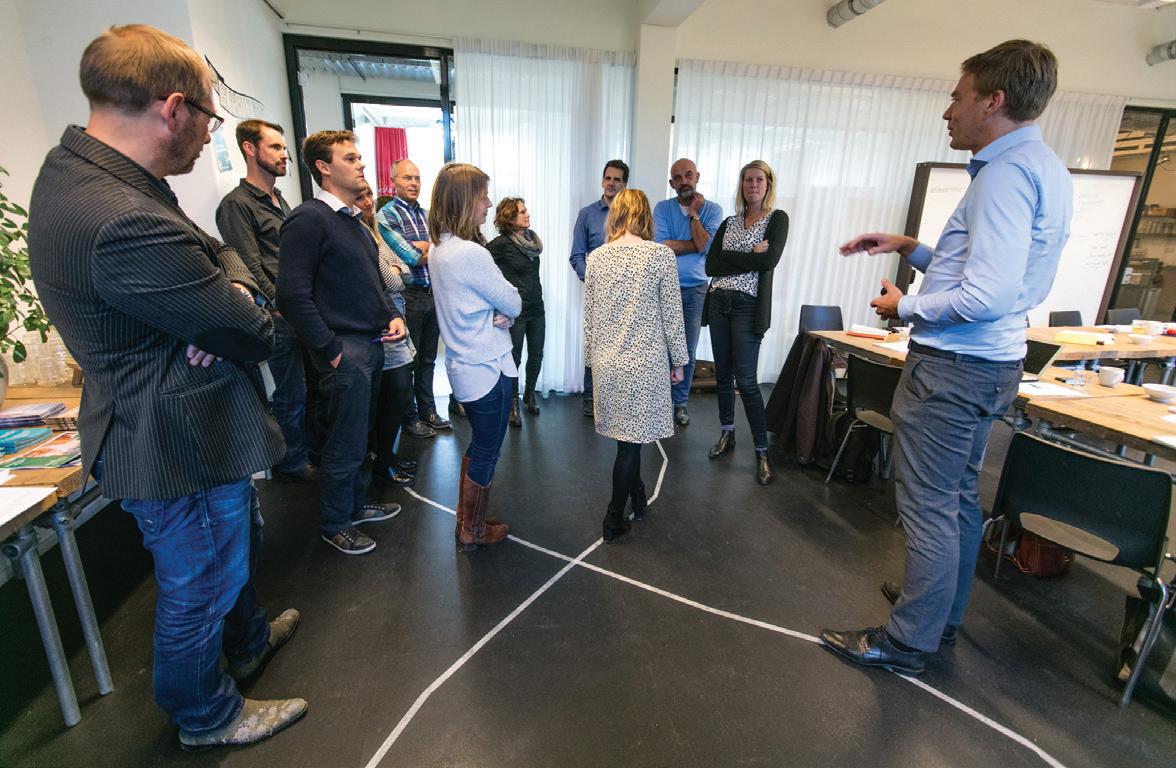
Guiding questions
• What stands out? And what does this mean?
• Is this a surprising image, or expected?
• What are common or similar elements?
• What elements can be grouped together in clusters?
• What are the most and least populated areas?
Based on these reflections, try to find more general insights
• What must be changed?
• What must be phased out?
• What must be built up?
• What must be institutionalised?
Blended format. If the case/project is well known by participants, mapping from initial steps can be implemented in advance through desk research and knowledge management by populating the canvas with existing information. The co-creation session can then start with a facilitated discussion around mapped elements, missing information and analysis of commonalities.

Co-creation session 2: Identifying interventions
STEP 5: RECAP SESSION 1
Start with a short recap of co-creation session 1 through a storytelling format integrating system boundaries, key elements of the future vision and the main outcome of session one. When sessions are separated in time, knowledge management can be applied to produce some summary infographics. Use simple visualisations or summary figures to facilitate reflections on insights about the two patterns and the most/least populated areas of the X-Curve (i.e. there was a lot of experimentation, but very little attention paid to breakdown).
STEP 6: IDENTIFY INTERVENTIONS
Establish a discussion regarding how to move forward into the action phase by recalling the X-Curve narrative. Each of the four quadrants represents an action perspective for working on practices, ideas and structures by following the two interrelated patterns (see figure).
Practical application
◎ Set groups according to the results and setting of session 1 and let participants identify potential interventions.
◎ First let participants reflect for themselves and write down ideas on (digital) Post-it notes or in a notebook.
◎ Then stick up the Post-it notes or share findings, with one person writing everything down on the sheet.
◎ Active facilitation is desirable. Encourage participants to request help or ensure that a facilitator is present to help participants on their way.
◎ Encourage participants to think about different types of interventions by using examples and guiding questions.
◎ Use any existing vision or visioning exercise to refresh key messages on desirable futures.
Guiding questions
• What interventions can you think of to foster or accelerate transformative innovations?
• How can we scale up and (further) institutionalise emerging practices with transformative potential?
• How can we challenge the status quo? What is needed to start a fundamental discussion about the future and direction of the system?
• Are there also elements of the current system that we are happy to further optimise? And why?
• What elements of the old system need to remain? And how can we convert them to be part of the ‘new normal’?
• How can we phase out certain ideas, structures, and positions? How do we deal with loss and losers of the transition? What possible interventions can we think of to guide this process of destabilisation and breakdown?
• What previously established ideas, structures and positions are already on their way out and how can we guide this final phase?

STEP 7: REFLECT ON INTERVENTIONS
The next step is to reflect per system on what type of interventions emerge as more relevant and how they make sense as part of a broad portfolio. Use guiding questions to trigger discussions among participants.
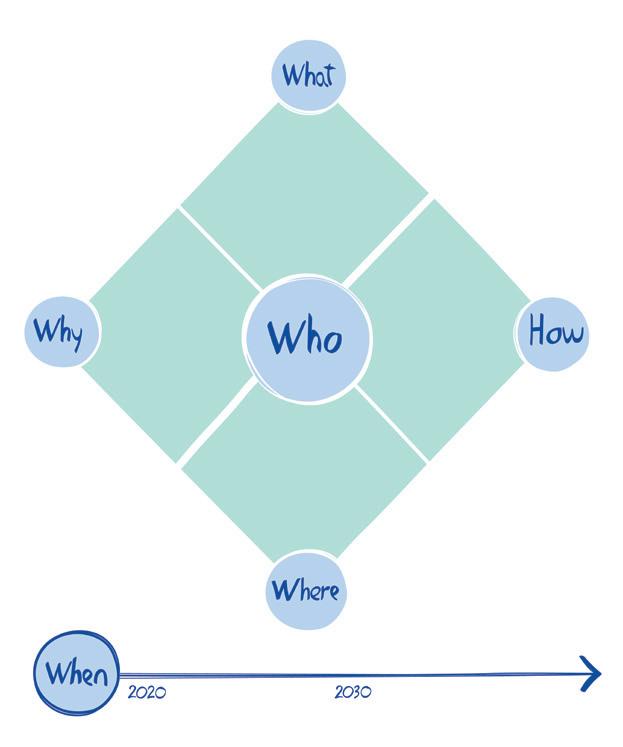
A portfolio approach provides a framework to transform rough preliminary ideas and prototypes into real opportunities by revealing potential synergies with the current strengths of the targeted system. It can be applied to explore, analyse and convert strategic priorities and objectives into innovation activities that are project-based. Not only does it look at the composition of the portfolio (list of innovation projects, initiatives or investments) and related problems, it also analyses what in the system and the relational structures allows a portfolio to be successful in the long term.
Guiding questions
• What interventions are more long-term, and which interventions are possible now?
• Which interventions match the skills/competencies/strengths of the participants, and for which interventions are we dependable on others/third parties?
• How do interventions address the needs for new knowledge & skills?
• Which concrete actions can we derive from this exercise and who can/should take them? Which funding/financial resources can be mapped out for those interventions?
• How can intervention facilitate innovative business models?
• What interventions enable systemic collaboration and new governance models?
• What are the alignments with existing local, national, and European/global policy frameworks? (i.e. smart specialization, covenant of mayors, SDGs, circular economy action plans)
STEP 8: MAIN TAKEAWAYS AND FOLLOW-UP
Finish the session by having participants exchange reflections on insights and lessons learned during the process. Focus on analysing the main insights in terms of action perspective, their potential and implications for their own role in fostering transitions.
For the project-based discussion, participants can prioritise which interventions are more feasible and suitable. Individual prototyped interventions can be presented in a new canvas sorting out key elements such as WHAT, WHO, WHERE, WHEN, HOW. A follow-up step can include an in-depth co-creation session to move forward with those prototypes.
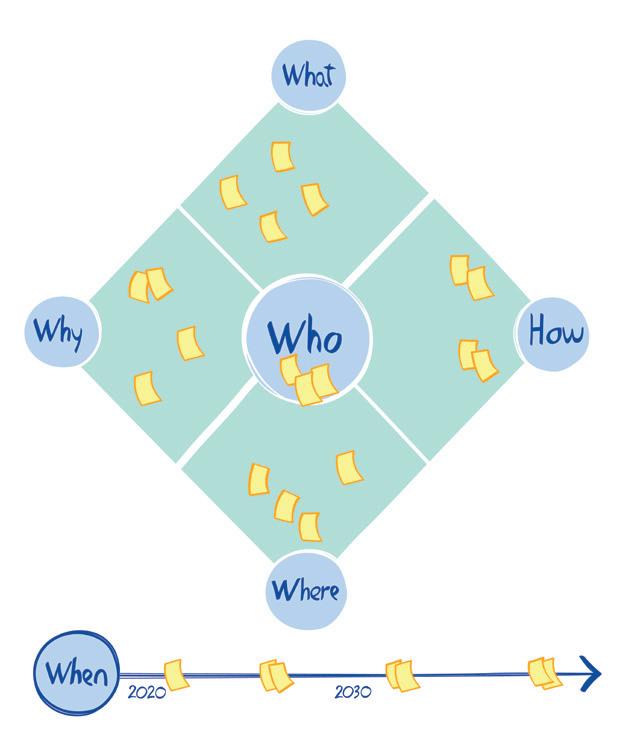
Programmes/agenda for co-creation sessions
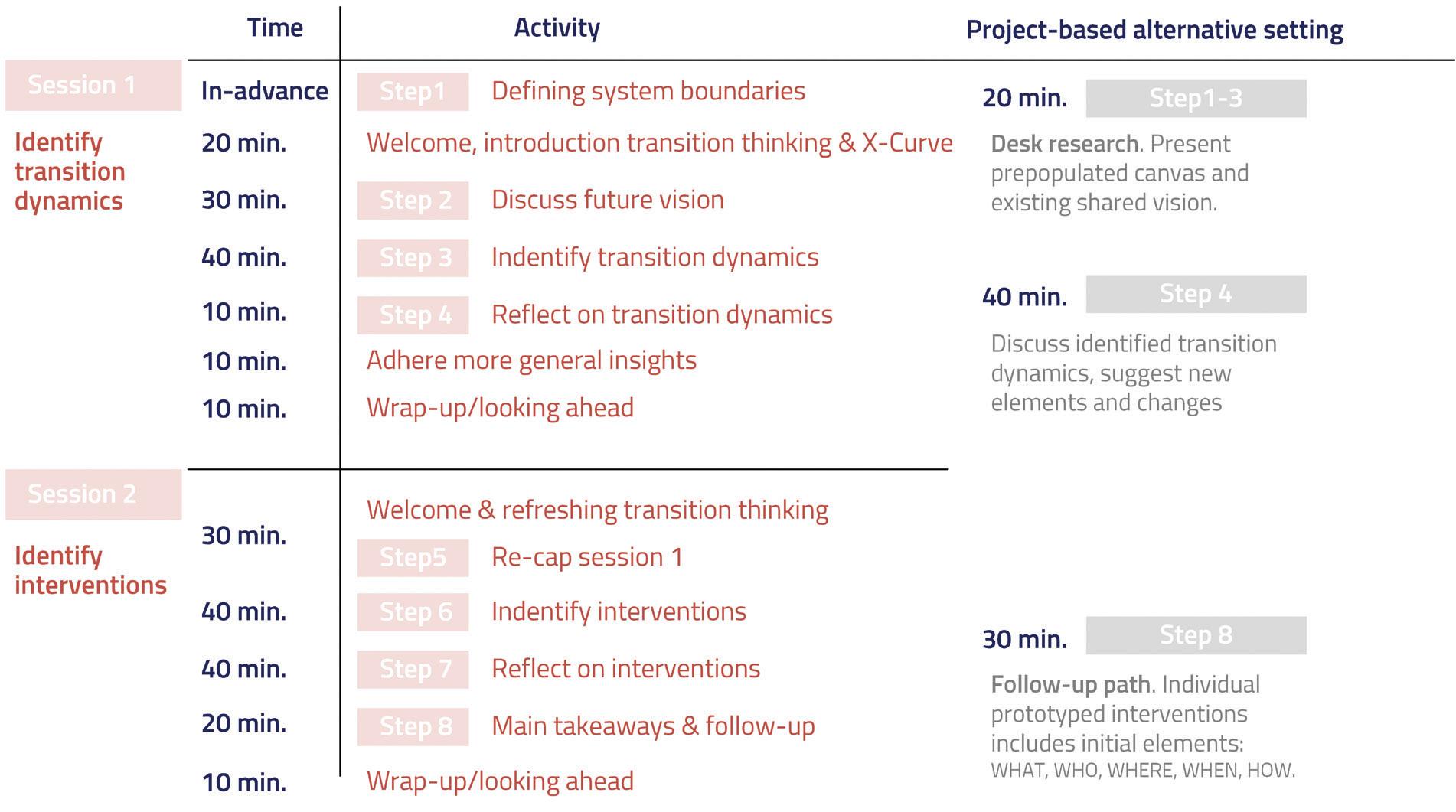
Co-creation sessions can be implemented by following the steps outlined in this document. Suggested workshop programmes are presented in the figure below.
For project-based contexts, an alternative setting is suggested. System mapping, visioning exercises and other input coming from project activities can be put together before the co-creation session, thus facilitating conversations in which participants can review the status quo and co-design potential interventions.
Team and resources
Consider that for the facilitation of both co-creation sessions you might need at least to cover three roles:
◎ Content expert: focusing on supporting participants to better understand the societal system under study.
◎ Process facilitator: focusing on facilitating the overall workshop by using facilitation methods and taking into consideration group dynamics.
◎ Reporter/storyteller: focusing on providing examples and harvesting while supporting the participants to share their insights and reflections.
Prior knowledge and skills. Delivery team must have some basic knowledge on sustainability transitions to design and implement the X-Curve. Additionally, analytical and strategic thinking as well as expertise on policy analysis is required.
Materials. The following are the suggested materials to prepare before a workshop:
Workshop type Materials and resources
In-person
• Printed X-Curve with four quadrants for each group of participants.
• Post-its, markers and pen; flipcharts
Digital • Digital canvas with X-Curve with four quadrants for each group of participants. (e.g. using online whiteboards)
• Clear instructions for participants regarding where and how to access this canvas
Both formats
• For session 1: narrative or vision for the selected cases
• For session 2: Infographics, posters or visualization of results from session 1
Tips & tricks for facilitators
◎ When explaining the X-Curve model to participants for the first time they might feel a bit confused. Give them time to reflect and share examples of transition dynamics related to their daily life or to their context.
◎ Continuously ask guiding questions supporting the participants to critically reflect and go beyond their comfort zone when identifying transition dynamics.
◎ Digital platforms for online interactions and workshops allow the process to move from a single workshop to a continuous and flexible process. The full co-creation process can be designed as a collection of workshops, conversations and desk research.
Knowledge management, sensemaking and learning
As a sensemaking tool, the X-Curve can be a powerful tool for harvesting data, analysing learning process and communicating insights and new knowledge on transition dynamics to a broad audience.
◎ The X-Curve can be applied in project-based desk research to present a case through a storytelling format.
◎ The X-Curve can be applied for single or multiple projects with data harvested from a pre-existing system mapping process.
◎ X-Curve storytelling can be used for capacity building actions to explore the common understanding of key concepts and negotiate meaning among different stakeholder perspectives.
◎ Sensemaking can be applied in different stages of a project's development, including the design, implementation and analysis of a broad portfolio of actions.
◎ Identified interventions can be the starting point for prototyping specific actions by combining tools and methods for policy co-design and sustainable business models.
